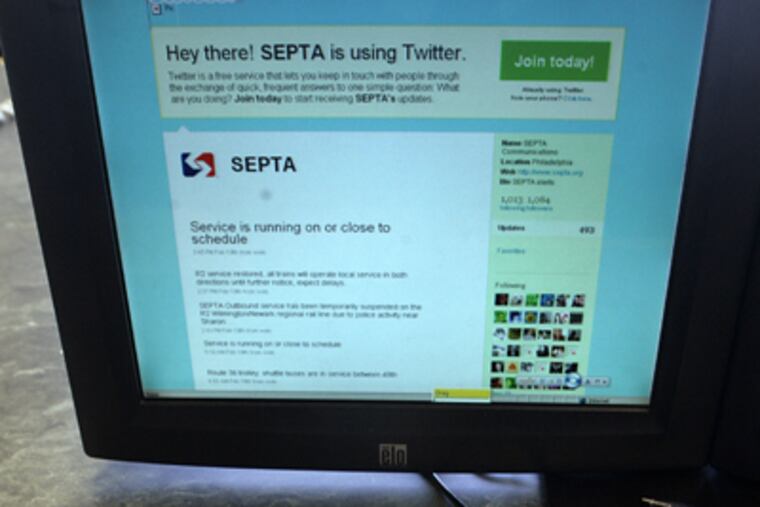SEPTA to partner with Google
SEPTA has gone Google. Schedules and routes for all SEPTA trains and trolleys will be synchronized with Web-based trip-planning program Google Transit, officials announced yesterday.

SEPTA has gone Google. Schedules and routes for all SEPTA trains and trolleys will be synchronized with Web-based trip-planning program Google Transit, officials announced yesterday.
On the Google Transit Web site, part of the larger Google Maps program, users can now enter a starting point and destination in the Philadelphia region - keywords like Independence Hall or movie theater or exact addresses - and Google will display a SEPTA route. Riders will still need to visit SEPTA's Web site for fare information.
"For us at SEPTA, it just provides another outlet for our information," said John Dezio, SEPTA senior operations planner.
Philadelphia is now one of more than 400 cities and regions worldwide that feed public-transit data into Google. Google Maps also provides directions for drivers and walkers.
New Jersey Transit, the Maryland Transit Administration, and public-transit authorities throughout New York already are linked to Google, according to SEPTA. Sharing data means SEPTA users can plan some inter-city trips using only public transportation.
Google Transit won't include SEPTA bus routes until the end of the year, said Ron Hopkins, operations control center chief. It is taking more time to coordinate data on the estimated 13,000 buses in the region than it did for the trains, he said.
Dezio said he hoped SEPTA's presence on Google would not only ease transit for regular riders but also introduce the system to tourists and newcomers.
"People are comfortable with Google," he said. "People might not be as comfortable with our trip planner."
The trip-planner section of SEPTA's site, which also allows users to plan a trip by entering a starting point and destination, is still running.
The announcement was greeted with enthusiasm by SEPTA riders, many of whom recently criticized SEPTA for delaying plans for a "smart-card" fare system.
"It's great," said daily R5 rider Tom Amo, a project manager with Comcast. "Technology is good, and SEPTA needs all the help they can get."
The map on SEPTA's Web site is confusing, he said, because it doesn't show the geographical location of stations. Google's maps, he said, will be an improvement.
Others were excited to plan trips around the region using a familiar tool. Calen Credle, 18, said she plans to use the program to visit friends in Darby, Delaware, and New Jersey.
Credle, a Community College of Philadelphia student planning a career as a paralegal, lives in West Philadelphia and rides buses and trains to get around the city.
"I would use it," she said. "Sometimes you have to guess what would be the best route to take. Maybe this will help."
While many think the partnership is a good idea, it won't stop Chris George, 18, from using his car after work or on weekends. The Washington University at St. Louis sophomore rides the R5 every day from Paoli to his internship at a Center City interior-design firm.
"I would never take SEPTA into the city" beyond commuting, George said. "I always drive."
Google launched the public-transit mapping program in 2005 for Portland, Ore. Google Transit's goal is to encourage travelers to learn their options before getting into a car, said Google spokesman Sean Carlson.
SEPTA started working with Google to merge transit data about a year ago, Dezio said. Given how many other metropolitan areas were already in the system, he said, the partnership was a natural next step for SEPTA.
Software to share data with Google was developed by SEPTA programmers at no additional cost to the agency, Dezio said.
The program works best on any phone with Google Maps already installed, Anderson said. For phones with a GPS locator, the program also can map public-transit routes from a user's location.
To further its technology-savvy agenda, SEPTA plans to roll out a program that will allow riders to track the status of Regional Rail trains within the next few weeks.
On Friday, SEPTA also will launch a Twitter account. Travelers will be able to "follow" SEPTA's Twitter account for travel alerts and other announcements.
SEPTA rider and Twitter user Maggie Gomez, 41, said she would consider following SEPTA on Twitter for updates on trains. Gomez takes the Market-Frankford El every day from the York-Dauphin station to her job as a secretary with the Environmental Protection Agency in Center City.
"They're keeping up with the technology," she said. "It's about time."